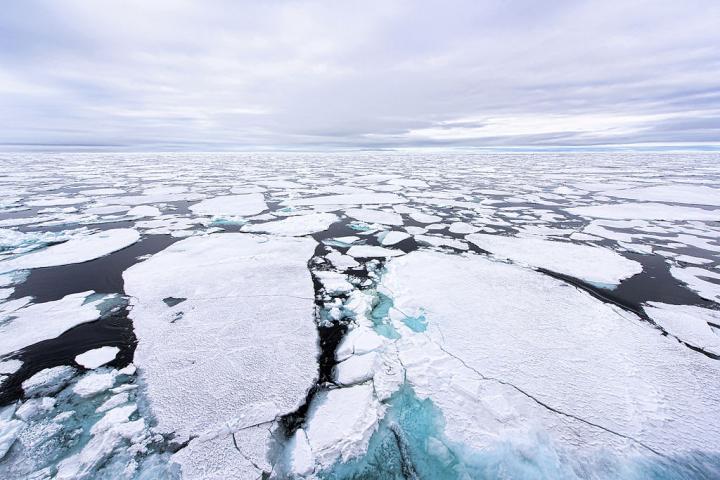
Credit: Christopher Michel
The movement of sea ice between Arctic countries is expected to significantly increase this century, raising the risk of more widely transporting pollutants like microplastics and oil, according to new research from CU Boulder.
The study in the American Geophysical Union journal Earth’s Future predicts that by mid-century, the average time it takes for sea ice to travel from one region to another will decrease by more than half, and the amount of sea ice exchanged between Arctic countries such as Russia, Norway, Canada and the United States will more than triple.
Increased interest in off-shore Arctic development, as well as shipping through the Central Arctic Ocean, may increase the amount of pollutants present in Arctic waters. And contaminants in frozen ice can travel much farther than those in open water moved by ocean currents.
“This means there is an increased potential for sea ice to quickly transport all kinds of materials with it, from algae to oil,” said Patricia DeRepentigny, doctoral candidate in the Department for Atmospheric and Oceanic Sciences. “That’s important to consider when putting together international laws to regulate what happens in the Arctic.”
Historically, floating masses of Arctic sea ice could survive for up to 10 years: building up layers, lasting through each summer and not moving very far during any given year. As the climate warms, however, that pattern has been changing.
While overall, the sea ice cover is thinning – and melting entirely across vast regions in the summer – the area of new ice formed during winter is actually increasing, particularly along the Russian coastline and soon in the Central Arctic Ocean. This thinner ice can move faster in the increasingly open waters of the Arctic, delivering the particles and pollutants it carries to waters of neighboring states.
“Ice moves faster, but as the climate warms, it doesn’t have as much time as before to travel before it melts,” said DeRepentigny. “Because of that, we really see that it’s the regions that are directly downstream of each country’s waters that are going to be most affected.”
Different emissions scenarios
In a previous study, DeRepentigny and her colleagues examined the movement of Arctic sea ice from the instrumental record starting in 1979, when the first continuous satellite observations began. That study was the first to document an increase in the amount of sea ice being transported from one region to another over the last four decades.
“That was really eye opening,” said DeRepentigny. “The follow-up question then was: How is this going to play out in the future? It opened a really big box of new questions.”
So the researchers used a global climate model, together with the Sea Ice Tracking Utility (SITU) – which DeRepentigny helped develop – to track sea ice from where it forms to where it ultimately melts during the 21st century.
The researchers considered two different emissions scenarios: the more extreme “business as usual” scenario, which predicts warming of 4 to 5 degrees Celsius by 2100, and a warming scenario limited to 2 degrees Celsius, inspired by the Paris Agreement. They then modeled how the sea ice will behave in both these scenarios at the middle and the end of the century.
In three of these four situations – including both mid-century predictions – the movement of sea ice between Arctic countries increased.
But in the high emissions scenario at the end of the century, they found countries could end up dealing more with their own ice and its contaminants, than ice from their neighbors. This is because with 4 degrees or more of warming in 2100, the majority of sea ice that freezes during winter will melt each spring in the same region where it was formed.
Russia and the Central Arctic
Russia’s exclusive economic zone and the Central Arctic Ocean are two places the researchers expect more ice to form, becoming major “exporters” of ice to other regions in the Arctic.
An exclusive economic zone (EEZ) is an area extending 200 nautical miles from the coastline, over which a state has special rights regarding fishing, shipping, and industrial activities like offshore oil drilling. Five countries have exclusive economic zones in the Arctic Ocean: Canada, the United States, Russia, Norway and Denmark (Greenland).
DeRepentigny and her colleagues found that the amount of ice originating from Russia that then melts in another exclusive economic zone doubles by mid-century.
However, the Central Arctic in the middle of the Arctic Ocean is a place where no country has exclusive economic rights. Due to the Arctic Ocean being more ice free in summers, this will become an attractive shipping route – especially because ships don’t need to get permission from another country to travel through it.
“That has several implications,” said DeRepentigny. “Who’s responsible for contaminants and materials that melt in the Central Arctic or get exported out of the Central Arctic into different countries? It’s no longer just a national question.”
###
Additional co-authors of this research include Alexandra Jahn at the University of Colorado Boulder, L. Bruno Tremblay at McGill University and Columbia University, Robert Newton at Columbia University, and Stephanie Pfirman at Arizona State University.
Media Contact
Kelsey Simpkins
[email protected]
720-204-2920
Original Source
https:/
Related Journal Article
http://dx.




